Siege of Acre (1103)
This article includes a list of general references, but it lacks sufficient corresponding inline citations. (October 2024) |
| Siege of Acre | |||||||
|---|---|---|---|---|---|---|---|
| Part of the Crusades | |||||||
 A siege tower in action; French depiction of the 19th century | |||||||
| |||||||
| Belligerents | |||||||
| Kingdom of Jerusalem | |||||||
| Commanders and leaders | |||||||
| Baldwin I | unknown | ||||||
| Strength | |||||||
| 5,000 men | Unknown | ||||||
| Casualties and losses | |||||||
| Unknown | |||||||
The siege of Acre took place in spring 1103 by crusader forces against the Fatimid coastal city of Acre.
Background
[edit]Baldwin's next target of conquest was Acre. In the spring of 1103, he began the siege of the city, which sits on a promontory on the northern edge of Haifa Bay. He was assisted by the remaining crews and passengers of the pilgrim fleet whose appearance had contributed decisively to the victory at the Battle of Jaffa the previous year. The Arab historian Ibn al-Athir reported on a naval blockade of Acre. However, the number of ships available on the Christian side was apparently not sufficient for a complete blockade, as subsequent events also showed. Also in the history of William of Tyre, the lack of ships was seen as decisive for the failure of the siege.
Siege
[edit]The besiegers, said to have numbered about 5,000 men, deployed catapults and a siege tower, which, after some prolonged fighting, eventually prompted the defenders to begin negotiations on the terms of the surrender. But shortly before the surrender of Acre, 12 Muslim galleys coming from Tyre and Sidon and a large transport ship with men and war material entered the city's harbor, in which these reinforcements revived the will to fight. The defenders did not only manage to defeat several of the siege engines, but also damaged the Crusader siege tower. King Baldwin then decided to break off the siege. The remaining siege engines were destroyed by the retreating Crusaders, and much of the orchards of Acre as well.
Aftermath
[edit]After the failure at Acre, King Baldwin made another advance into Mount Carmel to clear it of the gangs of bandits who were still making the traffic routes around Haifa unsafe from there. However, he was wounded in a skirmish, after which this endeavor had to be ended prematurely.[1]
References
[edit]- ^ Runciman 1952, p. 87.
Sources
[edit]- Runciman, Steven (1952). A History of the Crusades, Volume Two: The Kingdom of Jerusalem and the Frankish East, 1100-1187. Cambridge University Press. ISBN 9780521347716.
